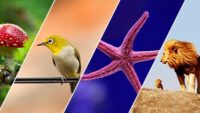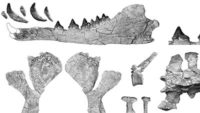By Dr. David Menton The secret ingredient to continual breathing? Water. …read more Source: AIG Daily
Have they now finally found a whale missing link, Peregocetus pacificus? …read more Source: creation.com
On April 10, 2019, a team of astronomers revealed the first-ever photograph of a black hole.1 Modern physics sees time and space as being interconnected, forming a kind of “fabric” or “membrane” called spacetime. A black hole is a region of spacetime that is extremely distorted by the presence of a sufficiently dense mass. The gravity in this region is so strong that anything getting too close to … More… …read more Source: icr.org
By Ken Ham The fossil record is full of (mostly marine) creatures that are now extinct. In an attempt to explain all this biodiversity that has since vanished, evolutionary scientists propose a series of mass extinctions caused by various catastrophes, though they frequently disagree on what those catastrophes were. One supposed extinction event, “the Great Dying,” is the subject of new research that claims volcanoes were responsible for wiping out 95% of life on earth. Researchers studied mercury levels in the geologic record from various sites and concluded that this mercury was released by volcanic activity. The massive amounts of [More]
Where do the lowest rocks in the rock record fit in the biblical timeframe? …read more Source: creation.com
How do black holes relate to biblical creation? …read more Source: creation.com
No, it’s evidence for Creation! …read more Source: creation.com
By Harry F. Sanders, III Life cycles are an interesting thing to study. Organisms are born and produce offspring in so many ways. …read more Source: AIG Daily
We’re all familiar with antibiotic resistance building in the human population.1 Antibiotics are widely prescribed, but many are largely unnecessary. This contributes to the development of “superbugs.”2 Evolutionists list antibiotic resistance as evidence of evolution3, but in reality it has nothing to do with the origin of antibiotic resistance genes4 More… …read more Source: icr.org
A geological guide book reveals landmarks, patterns, and puzzles. …read more Source: creation.com
By Dr. Andrew A. Snelling Anyone who doubts there was once a “lost world” during the ice age simply needs to visit the La Brea Tar Pits in downtown L.A. …read more Source: AIG Daily
When some early fossil hunters unearthed the bones of creatures, they recognised them as more than mythical animals. …read more Source: creation.com
By Troy Lacey Researchers looked at the most recent number of extrasolar planets in the habitable zone and applied an additional set of conditions needed for “life to form.” …read more Source: AIG Daily
By Ken Ham Headlines around the world trumpeted the news last week, “New species of early human found in the Philippines.” This “new species,” based on a collection of fossils found in a cave on the island of Luzon in the Philippines, has been named Homo luzonensis and has been dated to about 50,000 years. How should we as biblical creationists understand this find? A 17,000 Year Gap? Even in their own evolutionary view, the researchers can’t say this fossil tells us anything about the evolution of modern humans. Well, first off, notice the date—50,000 years. According to the current [More]
God gifted creation with natural builders to restore habitats and create ecosystems. Since April 7 is International Beaver Day, let’s look at the busy builders. …read more Source: AIG Daily
By Ken Ham The news has been buzzing recently with headlines such as this one from New Scientist, “Incredible fossil find may be first victims of dino-killer asteroid.” These headlines are announcing the discovery and analysis of a fossil deposit in America that is interpreted as “an unprecedented record of the mass extinction event that wiped out most of the dinosaurs 66 million years ago.” The article about this North Dakota find goes on to state, “The fossils appear to be animals that were killed within minutes of an asteroid striking Earth, in a flood triggered by the shattering impact.” [More]
Cell biologists have long focused on the tiniest of interactions: those between molecules. Recently, some researchers have zoomed out just a little to take a fresh look using new technologies at those cellular compartments, called organelles. Their discoveries give new insight into diseases, prompt a desire to redraw all the standard textbook cell pictures, and challenge anyone who still thinks of cells as simple blobs of protoplas… More… …read more Source: icr.org
How do we know what we know? The role of authority. Read More: Dystopian science 2 – creation.com
How published geological reports help develop a biblical interpretation. Read More
Because of grievous deficiencies in the standard neo-Darwinian Model of evolution, which is largely selection driven, scientists proposed an alternative postulate called the ‘Neutral Model’ in the late 1960s. The Neutral Model is also mutation driven, but selection is deemed to be an insignificant force of change. Instead, random genetic drift is alleged to be the main driver. Since its inception, the Neutral Model has come to be incorporated in many theoretical evolutionary scenarios at some level. However, due to numerous discoveries in genomics and genome function, the Neutral Model has also become deficient, prompting a new move in science [More]
Tiny diatom frustules reveal God’s beautiful design. Read More
By Troy Lacey A recent journal article features the discovery of a fossil (MUSM 3580) touted as a “walking whale,” in the Pisco Basin, located in the desert of Peru. …read more Source: AIG Daily
By Dr. Carrie John Recently published research discusses the synthesis of a large molecule which folded into a ring pattern and compared it to the folding of proteins. …read more Source: AIG Daily
By Ken Ham Scientists in Canada have announced their analysis of a 65% complete T. rex skeleton, painstakingly dug out of rock and analyzed over the past 29 years. Their estimates put this dinosaur at 28 years old at death and a whopping 19,500 pounds. Now that’s a big dinosaur! One of the lines in the National Geographic article on the announcement reminded me of a common question we are asked here at AiG. The article stated (emphasis added): The find suggests that large predatory dinosaurs probably got older and bigger than paleontologists would have surmised based on currently available [More]
It’s been known for decades that the hot pools of Yellowstone National Park contain exceptional and robust types of prokaryotic microorganisms called Archaea. Previously known as the archaebacteria, these organisms include methanogens (methane producers), extreme thermophiles (organisms resistant to heat), and extreme halophiles (organisms requiring salt for growth). One species of thermophilic archaea is Sulfolobus that can … More… …read more Source: icr.org
Termites (order Isoptera) are eusocial—animals with an advanced social organization—insects that can number in the millions, producing something biologists call a superorganism. This is defined as a colony of termites having features of organization analogous to the properties of a single creature. These insects have the ability to digest wood due to symbiotic gut-dwelling flagellates, single-celled eukaryotic creatures… More… …read more Source: icr.org
How do we know what we know? What is the role of authority? …read more Source: creation.com












































